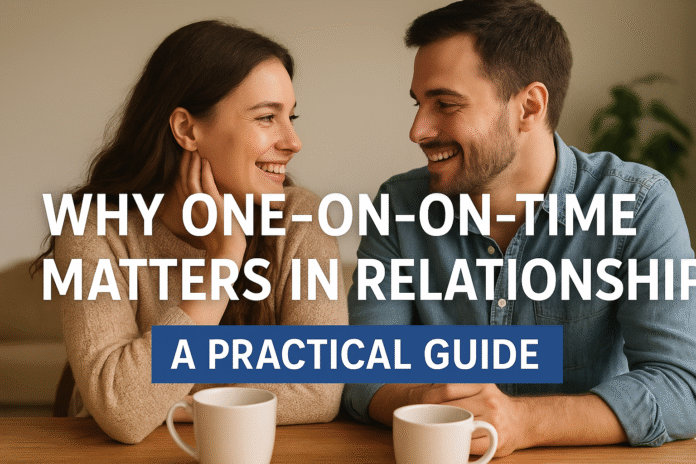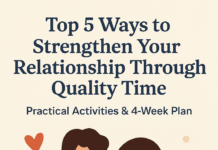Spending intentional one-on-one time with your partner is more than a feel-good activity — it’s the practical glue that keeps intimacy, trust, and emotional safety alive. In this article you’ll learn why one-on-one time matters, what science and relationship experts say about making it effective, how to plan and scale it, and a realistic 4-week starter plan you can use tonight. This piece is for couples at any stage — dating, newlyweds, long-term partners, or those rebuilding connection after stress or life changes.
Quick note / disclaimer: this article offers practical, evidence-informed guidance but is not a substitute for professional counseling. If you and your partner are facing abuse, severe mental-health issues, addiction, or ongoing emotional safety concerns, please consult a qualified mental-health or family professional for personalized help.
Key takeaways
- Quality matters more than quantity: intentional, engaged interactions (especially conversation and supportive behaviors) reliably predict greater relationship satisfaction.
- Small, regular rituals beat occasional grand gestures: weekly rituals plus daily micro-check-ins build steady closeness.
- Plan with flexibility: scheduling prevents “never enough time” while keeping the focus on responsiveness and warmth, not rigid rules.
- Measure what matters: mood during shared time, perceived support, and frequency of meaningful conversation are better metrics than hours logged.
- A simple 4-week plan can reset patterns: tiny, consistent steps (5–60 minutes) across four weeks create momentum and habit. (Starter plan included below.)
Why one-on-one time matters: purpose and core benefits
One-on-one time is intentional, undivided attention between partners — periods in which the couple prioritizes each other’s presence, emotions, and conversation without major distractions. Its core purposes are to maintain emotional connection, provide mutual support, and create a shared narrative that buffers stress and drift.
Core benefits
- Improved relationship satisfaction. Research shows that couples who spend a greater proportion of their time talking and engaging positively report higher relationship satisfaction and closeness.
- Better communication and conflict handling. The quality of everyday communication predicts future satisfaction; one-on-one time offers the space to repair small misunderstandings before they escalate.
- Emotional safety and perceived support. Feeling supported in the relationship during shared time predicts long-term happiness and resilience during stress.
- Sexual and romantic satisfaction. Couples who regularly plan time together often report higher romantic and sexual satisfaction, with repeated surveys linking “date nights” to better outcomes.
What one-on-one time looks like (requirements, low-cost alternatives)
What it is
- A range from micro-moments (5 minutes of undistracted check-in) to longer rituals (a weekly date night, an hour-long walk, or an overnight away together). Quality conversation, eye contact, shared laughter, and physical affection often define its effectiveness.
Prerequisites / costs
- Time and intention. The primary “cost” is scheduling and resisting distractions.
- Basic skills. Active listening, curiosity, and simple planning ability are helpful but learnable.
- Optional extras. Dates can include financial outlays (dinners, tickets), but low-cost alternatives (walks, home-cooked dinners, game night) work just as well.
Low-cost alternatives
- Micro-check-ins (5 minutes): a purposeful check-in at breakfast or before bed.
- Walk-and-talks: 20–30 minute strolls are free and supportive of conversation.
- Cozy home date: turn off screens, light a candle, and cook together.
- Shared chores ritual: make a mundane task into a shared mini-ritual to talk and collaborate.
Step-by-step: how to implement one-on-one time for beginners
- Decide what counts. Agree together on what types of activities will be considered “one-on-one time” (e.g., no phones, five-minute check-ins, weekly date).
- Start micro: pick 5–10 minutes per day for an undistracted check-in for the first week. Use an alarm or calendar if needed.
- Create a ritual: choose a recurring slot (e.g., Friday evenings, Sunday morning coffee) and protect it. Small rituals anchor the habit.
- Use open-ended prompts. Ask questions that invite sharing (see sample prompts below).
- Practice “soft start” and “soft end.” Begin with a warm, low-stakes opener (a compliment or curiosity) and end with appreciation.
- Scale gradually: after two weeks, expand one of the daily check-ins into a 30–60 minute activity such as a walk, date, or shared hobby.
- Review and tweak weekly: spend five minutes to reflect on what felt good and what to change.
Sample starter prompts
- “What was the best part of your day and why?”
- “Is there anything you’d like more support with this week?”
- “What’s one small thing I could do that would make you feel loved right now?”
Beginner modifications and progressions
Simplify
- If your schedule is slammed, start with a 2-minute gratitude exchange each night.
- If screens always interrupt, try a “no phones for 15 minutes” rule while having tea.
Progress
- Move from 5-minute check-ins to a 35-minute intimacy ritual each week (five minutes of affection daily × 7 ≈ 35 minutes — a simple guideline promoted by relationship researchers).
- Add a monthly “deep conversation” night where you explore goals, stresses, or dreams for 60–90 minutes with guided prompts.
Recommended frequency, duration, and measurable metrics
Guidelines (not rules)
- Daily micro-check-ins: 5 minutes — quick mood, one supportive statement, or a brief gratitude. Helpful to keep tone and responsiveness high.
- Weekly ritual (date or focused time): 60–120 minutes — a weekly protected slot is widely recommended and associated with higher reported satisfaction in multiple surveys.
- Monthly deeper connection activity: 2–4 hours — longer shared experiences (mini-getaway, a class together) strengthen the couple story and create new shared memories.
Suggested metrics to track progress
- Mood during/after time together: simple 1–5 scale the two of you share after each session.
- Perceived support score: once a week ask, “On a scale of 1–10, how supported do you feel?” Track trends over a month.
- Number of distraction-free sessions per week: count how many times you truly stayed phone-free and engaged.
Safety, caveats, and common mistakes to avoid
Safety and emotional vulnerability
- One-on-one time can surface hard feelings. If either partner has trauma or if conversations escalate, pause and use calming techniques or seek professional support.
- Avoid pressuring your partner to share; mutual consent and emotional safety are essential.
Common mistakes
- Confusing quantity with quality. More time without engagement is less effective than shorter, focused time.
- Using time to “fix” instead of listen. One-on-one time should prioritize presence; problem-solving is fine but should not dominate every interaction.
- Rigid scheduling without flexibility. Over-scheduling can make connection feel like an obligation; balance structure with spontaneity.
- Digital distractions. Phones are one of the biggest barriers. Create clear phone boundaries for your shared time.
Mini-plans (2–3 steps) you can try tonight
Micro-check-in (5 minutes)
- Put phones away for 5 minutes.
- Each partner answers: “One highlight from today” + “one way I could use support.”
- End with a quick appreciation.
Low-cost home date (45 minutes)
- Turn off TVs and phones; choose soft lighting.
- Cook or prepare a simple snack together while you chat about a fun memory.
- Finish with a 10-minute walk or cuddle time and say one thing you appreciate.
Repair-focused mini-plan after a rough day (15 minutes)
- Each partner names one thing that went badly and one thing they wish for tomorrow.
- Use “I feel” statements and avoid blame.
- End with one supportive action agreed for the next day.
Practical add-ons: quick-start checklist and warm-up
Quick-start checklist
- Agree what counts as one-on-one time.
- Block one weekly slot in your calendars.
- Choose a 5-minute daily check-in time (morning, lunch, or bedtime).
- Pick one device-free rule for sessions.
- Keep a small shared journal or note for appreciations and topics to discuss.
Warm-up (2-minute ritual)
- Sit facing each other for 60 seconds, make eye contact, and share one short appreciation. This lowers defenses and primes good conversation.
Troubleshooting and common pitfalls (with fixes)
Problem: “We tried and it felt awkward.”
- Fix: Start smaller. Five minutes of “what made you smile today?” reduces pressure and builds momentum.
Problem: “One partner resists scheduling.”
- Fix: Explore reluctance non-defensively. Ask “what would make this easier for you?” and negotiate a lower-stakes option (a monthly 30-minute slot instead of weekly).
Problem: “We talk but don’t feel closer.”
- Fix: Shift focus from problem-solving to curiosity. Use open-ended questions and reflective listening (repeat back the main feeling you heard).
Problem: “Time together always becomes about chores or kids.”
- Fix: Designate a specific “adult-only” ritual (even 30 minutes) and arrange childcare or swap childcare duties with a friend/family for that slot if possible.
Problem: “I’m tired after work and can’t engage.”
- Fix: Acknowledge fatigue openly. Try a low-energy ritual like sitting together quietly for 10 minutes or a 15-minute walk to decompress before talking.
How to measure progress and know if it’s working
Short-term signals (first 2–4 weeks)
- More frequent small positive interactions.
- Both partners report feeling slightly more understood or less defensive after check-ins.
Medium-term signals (1–3 months)
- Increase in perceived support scores and satisfaction with shared time.
- Fewer unresolved small conflicts that used to fester.
Long-term signals (6+ months)
- Greater resilience during life stressors, higher reported relationship satisfaction in surveys, and a stronger couple narrative about “we can handle things together.” Research links consistent shared time and planned dates with higher reports of relationship happiness.
Practical measurement tools
- Shared weekly check-in poll (1–5 scale) logged in a notes app.
- Monthly reflection: two minutes each to say what’s improved and what to tweak.
A simple 4-week starter plan (roadmap)
A practical, low-friction plan that gradually builds from micro-check-ins to a protected weekly ritual.
Week 1 — Activate micro-habits
- Daily: 5-minute device-free check-in (mood + one support request).
- Weekly: Schedule a 30-minute “planning slot” this week to pick your weekly ritual time going forward.
- Measure: Rate mood after each check-in (1–5).
Week 2 — Add a short shared activity
- Daily: Keep 5-minute check-ins.
- Twice this week: Add a 20–30 minute shared activity (walk, cook together, or sit outside).
- Nightly: Leave a one-line appreciation in a shared note.
- Measure: Perceived support score once this week (1–10).
Week 3 — Protect a weekly ritual
- Daily: 5-minute check-ins continue.
- Weekly ritual: 60–90 minute date (home or out). Agree to make this device-free.
- Reflect: After the weekly ritual, each partner names one thing felt good and one small tweak.
- Measure: Count distraction-free minutes during the weekly ritual.
Week 4 — Deepen and stabilize
- Daily: Keep 5-minute check-ins.
- Weekly: Continue the 60–90 minute ritual. Add a short “future goals” conversation (20 minutes) in the week.
- Plan next month: Choose two recurring slots that work for both (one weekly ritual and a monthly longer experience).
- Measure: Compare mood & support ratings from Week 1 to Week 4 and discuss changes.
Mini-check after four weeks
- Ask: “On a scale of 1–10, how connected do you feel compared to four weeks ago?” Use the answer as a conversation starter rather than a performance metric.
Evidence-informed tips (practical credibility cues)
- Talk more about ordinary life, not just major events. Low-salience interactions add up; everyday conversations predict satisfaction above and beyond big events.
- Planing date nights matters — but plan for quality. Dates that promote closeness (curiosity, positive mood, mutual support) are the most effective. Simply scheduling without attention to interaction quality may not help.
- Buy back time where possible. Households who outsource certain chores can free minutes for quality time, which indirectly boosts satisfaction when that time is used well.
Long-term maintenance: rituals, rules, and the “2-2-2” idea
Several practical rules-of-thumb exist to help couples maintain connection long-term:
- Weekly date night — a protected 1–2 hour slot many experts recommend for routine maintenance. Survey data shows regular date nights associate with higher marital happiness.
- Daily micro-routines — 5 minutes of affection or check-in per day helps sustain warmth.
- 2-2-2 rule (optional) — date every two weeks, a weekend away every two months, a week-long vacation every two years. It’s a flexible guide, not a mandate; adapt to your life. Verywell Mind
When one-on-one time may not be enough (and what to do)
If patterns don’t change despite hard work
- There are situations where one-on-one time helps less: unresolved trauma, one partner’s emotional unavailability, severe depression, addiction, or consistent power imbalance.
- Action: Consider couples therapy or specialized support. One-on-one time is a tool, not a cure-all.
If time together increases conflict
- Sometimes closeness brings up latent issues. Set ground rules for repair: time-outs, calm-down strategies, and scheduling deeper conversations when both partners are rested.
FAQs (8–12)
1. How much one-on-one time do couples really need?
There’s no universal number; many couples benefit from daily micro-check-ins (5 minutes) plus a weekly ritual of 60–120 minutes. Research links regular shared time and quality conversations with higher satisfaction.
2. Is “date night” necessary or overrated?
Date nights can be helpful if they produce closeness and positive mood. Poorly planned dates (distraction, stress, or obligation) won’t help. Focus on quality, not just the label.
3. What if my partner doesn’t want to schedule time?
Start smaller and negotiate: a 2-minute nightly ritual or a monthly 30-minute slot. Ask gently about barriers and co-design the plan. Consider that resistance can signal stress, exhaustion, or fear of vulnerability.
4. Can one-on-one time improve sex life?
Yes — couples who prioritize time together often report higher sexual satisfaction, likely because closeness and perceived support foster intimacy.
5. Are expensive dates better?
No. Shared positive mood, curiosity, and perceived support matter more than cost. Simple, low-cost activities often produce equal or better outcomes.
6. How to keep one-on-one time fresh after years together?
Rotate activities, introduce novelty occasionally, and use structured deep-conversation prompts. Even small changes break routines and invite curiosity.
7. What if we have kids — is weekly time realistic?
Yes — many parents carve a weekly window by sharing childcare duties, swapping with friends/family, or scheduling short but consistent in-home rituals. The key is protection and predictability.
8. Is it okay to be apart a lot and still have a healthy relationship?
Long-distance relationships can thrive with high-quality communication and planned shared time. The proportion of time spent talking and the perceived quality of those interactions predict satisfaction.
9. How to handle disagreements during one-on-one time?
Use brief ground rules: take a pause if emotions run high, use “I” statements, and schedule a calm time to continue the talk. Prioritize repair over being right.
10. What measures show this is working?
Track mood after interactions, perceived support scores, fewer recurring petty conflicts, and increased warmth/affection. Self-rated satisfaction improvements over weeks are a good sign. Harvard Business School
11. Should one person always be the organizer?
Shared responsibility is best. When one partner always manages, imbalance and resentment can follow. Rotate planning and invite contributions.
12. When should we see a therapist?
If one-on-one efforts leave either partner feeling worse, if there’s ongoing safety concern, or if entrenched patterns resist change, professional help is a wise next step.
Final thoughts and practical encouragement
Cultivating one-on-one time is a practical, doable, and often underrated investment. It doesn’t require grand gestures — it asks for attention, curiosity, and consistency. Start tiny tonight with a two-minute warm-up, protect one weekly hour, and measure what matters: mood, perceived support, and simple rituals that make your partnership more resilient.
Take the first step tonight: put phones away, face each other for five minutes, ask “What was one small win today?” and listen.
Call to action: Try the Week 1 micro-habit tonight — then check in here for a tweak or next-step plan.
References
- Time Spent Together in Intimate Relationships: Implications for Relationship Functioning — Public Library of Science / PubMed Central, 2021. . PMC
- Time Spent Together in Intimate Relationships — PubMed (National Library of Medicine), 2021. . PubMed
- Within-Couple Associations Between Communication and Relationship Satisfaction — Public Library of Science / PMC, 2022. . PMC
- 6 Hours a Week to a Better Relationship — The Gottman Institute (blog), 2024. . Gottman Institute
- Date Your Spouse and Stay Happily Married — Institute for Family Studies (blog), 2023. . Institute for Family Studies
- Planning Date Nights That Promote Closeness (scholarly article) — PubMed Central, 2021. . PMC
- The Date Night Opportunity (report / PDF) — Wheatley Institute / National Marriage Project, 2022. . Wheatley Center
- Date Night — The Opportunity (PDF summary) — National Marriage Project (PDF), 2023. . nationalmarriageproject.org
- Buying Quality Time and Relationship Satisfaction — Short Summary (PDF) — Marriage Foundation (note), 2024. . Marriage Foundation
- From Time to Quality Time: Making Every Moment Count (extension article) — Utah State University Extension, 2020. . Utah State University Extension
- How Often Should Married Couples Go On Dates? (survey analysis) — The Knot (article), 2024. . The Knot
- The Power of Date Nights (blog) — Institute for Family Studies, 2023. . Institute for Family Studies
- Can You Schedule Your Way To A Better Relationship? (article) — TheCandidly, 2024. . The Candidly




































